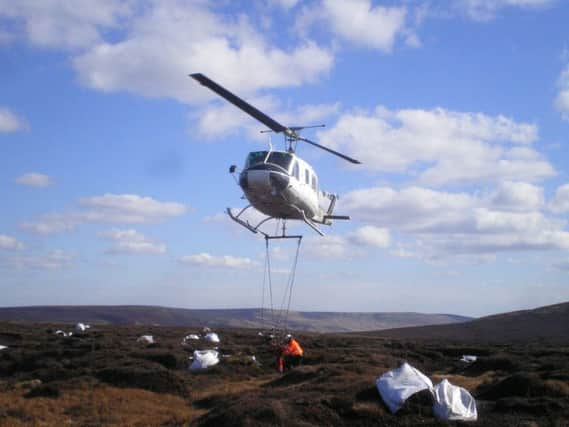Huge airlift near Huddersfield gets next stage of vital peatland restoration underway


A workforce of about a dozen is spreading cut heather from 390 giant bags that have been airlifted onto the moor above Deanhead reservoir near Scammonden.
The work is part of a wider project, funded by the European Union to the tune of €16m - or approximately £14m, which aims to restore bare patches of peatland to active blanket bog across the South Pennines Special Area of Conservation.
Advertisement
Hide AdAdvertisement
Hide AdUnsheltered area of bare soil is vulnerable to erosion at moorland altitudes, making the recolonisation of the landscapes by valuable plant species almost impossible without human intervention.
A combination of acid rain and wildfires have contributed to the decline of these peatland habitats and their restoration should help sphagnum moss to thrive. This species of moss contributes to the supply of clean drinking water and also acts as a useful natural flood prevention tool.
The conservation work is being undertaken by the Moors for the Future Partnership as part of the five-year MoorLIFE 2020 project.
Explaining why the scheme is so important, Dewi Jackson, conservation works officer for the Moors for the Future Partnership, said: “Blanket bog moors like those surrounding Deanhead reservoir provide a wealth of benefits to both people and animals.
Advertisement
Hide AdAdvertisement
Hide Ad“They provide a home to unique wildlife like the mountain hare and curlew, and help to store carbon.”
Across England, blanket bog stores more than three billion tonnes of carbon in the ground - a total that exceeds the combined capacity of all the country’s woodlands and forests.
Ms Jackson added that blanket bog was essential if sphagnum moss is to thrive.
“Sphagnum moss is the building block to peat landscapes and plays a vital role in helping to clean our drinking water before it flows through our taps, and keeping water on the moors for longer, reducing the risk of flooding in local communities.”
Advertisement
Hide AdAdvertisement
Hide AdThe undertaking above Deanhead reservoir involves spreading the cut heather across two hectares of bare peat, then applying lime, seed and fertiliser to encourage grass to grow.
The brash and grasses together stabilise the eroding peat and provide the right conditions for native blanket bog species, such as sphagnum moss, crowberry, cotton grass and heather, to recolonise.
The work is intended to complement other ongoing restoration efforts that involve re-wetting the moor by blocking erosion gullies and pro-actively planting sphagnum moss.
Another benefit of the project is reduced soil erosion which will mean that drinking water collected by Yorkshire Water in the nearby reservoir has less sediment in it before it is treated.
Advertisement
Hide AdAdvertisement
Hide AdYorkshire Water is a partner of the MoorLIFE 2020 project, which is managed by the Peak District National Park. The water firm contributes additional funding along with Severn Trent Water and United Utilities.
Natural England and the Environment Agency, as well as local landowners, are helping to advise the work which is being delivered by the Peak District National Park Authority, the National Trust, RSPB and rural regeneration company, Pennine Prospects.
Over the next few years the partners will work together to help conserve and enhance 43 sq miles of peat moorland, much of which is designated as a Site of Special Scientific Interest.